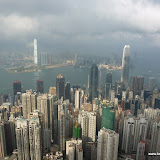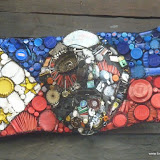Plunging in India, but not in the Ganges.
What a crazy place is India ! We spent our first days in the country with Louella, our lovely couchsurfing host, thanks to whom we have enjoyed a few quite bucolic days in Mumbai (Bombay). Hosting is an art in India : not only did she made us feel at home, but she did not leave for work until she made sure we were properly established at her place and acquainted with Mumbai's public transport system. She also asked a friend to come fetch us at dawn the next day to take us to the city's National Park where there are Budist caves dating from the 10th century carved in the stone. Even her mother, who leaves in the neighbourhood, asked us to come meet her and have breakfast a second time, just in case her daughter had not fed us well enough.

After a couple of days in such a great company, we took a flight to Varanasi (ex-Benares), which is one of the oldest towns in the World, as well as a very important sacred destination for Hindus. Mumbai is bursting with people and the crowds trying to catch the suburban train at rush hour any given day are worse than those on a public transport strike day in Madrid or Paris. However, it still feels relaxed compared to Varanasi. Definitely, the vision of India we had built in our heads, based on our readings and what we had been told by other travellers, felt short of the reality we met at our arrival into this picturesque city.
Narrow and labyrinthine medieval streets are carpeted with cow droppings and other dirt (if it is true that stepping on pooh ensures luck, then we must have cumulated enough for our next three lives, as our hotel was in a badly lighted lane). Monkeys reign on rooftops while cows walk freely in the streets, eating whatever they find. And indeed there are quite a lot of stables built directly inside the city limits. For example, in our favourite restaurant, clean and hygienic as few, located in a beautiful patio with a temple, if you walk just a few steps up to the temple you will discover that a wall separates it from a cow shed.

In the few wider streets, there is a thick and non-stop traffic of rickshaws, bicycles, motorcycles, cars, seller stalls and people dodging each other in a chaotic way and using freely their oversized horn. Quite often a cow decides to have a rest in the middle of the street complicating furthermore the traffic. And cows here are so stolid ! I must admit that coming from Spain I am quite distrustful of them. Indeed, I never thought I would ever in my life dare to get this close to a bull horns as I have here, but since cattle here is so calm and docile it is hardly something one can boast about.
Then, there are the Ganges banks, some hosting burning piers, others piles of laundry being washed and dried, or yet others believers and buffalos bathing and purifying in a water not precisely known for its purity level (I would probably disintegrate if I dared to go in there). Goats go up and down the ghats looking for a shadowed corner or sneaking to steal the death's flower collars. Walking in town you cross a colourful mix made of pilgrims with their heads shaved (both men and women) walking in line, funeral processions, women in sari, men in kurta/dothi, meditating hermits (some with their long hair dressed around the head like a turban), people wearing western style clothes and even a few women in burqa. But the most shocking individual was the hard-core ascetic that we saw going around town as naked as the day he was born.

What we have seen (or rather, what blew our minds) in this first week in India, is enough to write a thousand posts since, as the add says, this is really an Incredible country.
Bea

After a couple of days in such a great company, we took a flight to Varanasi (ex-Benares), which is one of the oldest towns in the World, as well as a very important sacred destination for Hindus. Mumbai is bursting with people and the crowds trying to catch the suburban train at rush hour any given day are worse than those on a public transport strike day in Madrid or Paris. However, it still feels relaxed compared to Varanasi. Definitely, the vision of India we had built in our heads, based on our readings and what we had been told by other travellers, felt short of the reality we met at our arrival into this picturesque city.
Narrow and labyrinthine medieval streets are carpeted with cow droppings and other dirt (if it is true that stepping on pooh ensures luck, then we must have cumulated enough for our next three lives, as our hotel was in a badly lighted lane). Monkeys reign on rooftops while cows walk freely in the streets, eating whatever they find. And indeed there are quite a lot of stables built directly inside the city limits. For example, in our favourite restaurant, clean and hygienic as few, located in a beautiful patio with a temple, if you walk just a few steps up to the temple you will discover that a wall separates it from a cow shed.

In the few wider streets, there is a thick and non-stop traffic of rickshaws, bicycles, motorcycles, cars, seller stalls and people dodging each other in a chaotic way and using freely their oversized horn. Quite often a cow decides to have a rest in the middle of the street complicating furthermore the traffic. And cows here are so stolid ! I must admit that coming from Spain I am quite distrustful of them. Indeed, I never thought I would ever in my life dare to get this close to a bull horns as I have here, but since cattle here is so calm and docile it is hardly something one can boast about.
Then, there are the Ganges banks, some hosting burning piers, others piles of laundry being washed and dried, or yet others believers and buffalos bathing and purifying in a water not precisely known for its purity level (I would probably disintegrate if I dared to go in there). Goats go up and down the ghats looking for a shadowed corner or sneaking to steal the death's flower collars. Walking in town you cross a colourful mix made of pilgrims with their heads shaved (both men and women) walking in line, funeral processions, women in sari, men in kurta/dothi, meditating hermits (some with their long hair dressed around the head like a turban), people wearing western style clothes and even a few women in burqa. But the most shocking individual was the hard-core ascetic that we saw going around town as naked as the day he was born.

What we have seen (or rather, what blew our minds) in this first week in India, is enough to write a thousand posts since, as the add says, this is really an Incredible country.
Bea
















